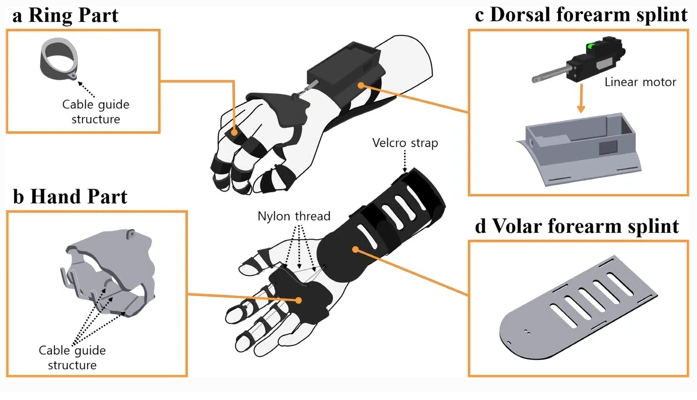




In the recently published ‘Development of 3D-printed myoelectric hand orthosis for patients with spinal cord injury,’ South Korean researchers propose the design for an innovative new wearable medical device meant to assist spinal cord injury patients in achieving greater hand function.
While researchers and manufacturers around the world have engineered numerous orthotics and prosthetics—from those meant for the ankle and feet to the hands and arms—the researchers point out the motivation behind their study as so few upper extremity orthoses have been created for successful functionality in patients. Previous research has focused on materials and strength but not actual affordability and ease in ease for patients.
The orthosis created for this study functions via customized electromyography (EMG) signals which send input to the controller, all of which can intuitively understand user intention for patients with cervical SCI. The team designed the parts in SolidWorks, and then they were 3D printed on a Moment2, using PLA. The device costs around $230 to make, and that is supposed to decrease further in the future.
The orthosis is made up of the forearm cuff, hand, and finger ring parts. The cuff is also comprised of a dorsal and volar forearm splint, featuring a linear motor controlling the wrist extension.
Users can grasp objects when the motor is activated—emphasizing one of the main features that sets this device apart as more people can use the device—especially patients with more severe SCI and lack of wrist control.
The researchers employed an Arduino microcontroller board with a small control unit meant for portability at 10 cm × 5.3 cm × 1.7 cm and 81 g.
Ten patients with chronic cervical SCI—nine men and one woman all in the 31- to 65-year-old range—participated in the study from March 27th, 2019 to April 31st, 2019.
Overall, as the researchers worked with the participants, they found that the orthosis was able to ‘significantly improve’ hand function for people for cervical SCI, and they received good feedback regarding usability of the device. The researchers also expect even better results as the individuals participating continue to adapt to the system.
Source:3dprint.com

In the recently published ‘Development of 3D-printed myoelectric hand orthosis for patients with spinal cord injury,’ South Korean researchers propose the design for an innovative new wearable medical device meant to assist spinal cord injury patients in achieving greater hand function.
While researchers and manufacturers around the world have engineered numerous orthotics and prosthetics—from those meant for the ankle and feet to the hands and arms—the researchers point out the motivation behind their study as so few upper extremity orthoses have been created for successful functionality in patients. Previous research has focused on materials and strength but not actual affordability and ease in ease for patients.
The orthosis created for this study functions via customized electromyography (EMG) signals which send input to the controller, all of which can intuitively understand user intention for patients with cervical SCI. The team designed the parts in SolidWorks, and then they were 3D printed on a Moment2, using PLA. The device costs around $230 to make, and that is supposed to decrease further in the future.
The orthosis is made up of the forearm cuff, hand, and finger ring parts. The cuff is also comprised of a dorsal and volar forearm splint, featuring a linear motor controlling the wrist extension.
Users can grasp objects when the motor is activated—emphasizing one of the main features that sets this device apart as more people can use the device—especially patients with more severe SCI and lack of wrist control.
The researchers employed an Arduino microcontroller board with a small control unit meant for portability at 10 cm × 5.3 cm × 1.7 cm and 81 g.
Ten patients with chronic cervical SCI—nine men and one woman all in the 31- to 65-year-old range—participated in the study from March 27th, 2019 to April 31st, 2019.
Overall, as the researchers worked with the participants, they found that the orthosis was able to ‘significantly improve’ hand function for people for cervical SCI, and they received good feedback regarding usability of the device. The researchers also expect even better results as the individuals participating continue to adapt to the system.
Source:3dprint.com